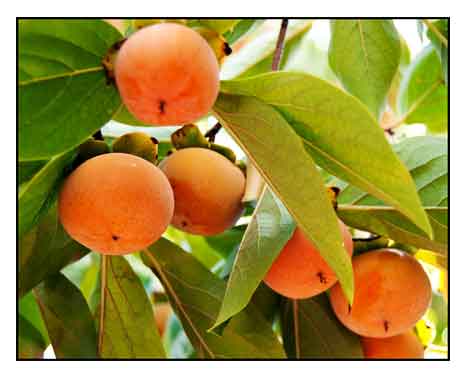 Gen info Gen info
- Diospyros is a genus of over 700 species of deciduous and evergreen trees and shrubs. The majority are native to the tropics. Some are valued for their hard, dark, and heavy timber; others valued for fruits; some used as ornamentals.
- Etymology: Diospyros derives from the Greek words "Dios" referring to the god Jupiter, and"pyros" meaning "wheat", together, the wheat of Jupiter.
(31)
The English word Persimmon is derived from the Algonquian language of the eastern United States meaning "dry fruit". (35)
- In Chinese legend, the persimmon tree embodies seven virtues: the sweetness of the fruits, the sturdy wood, the longevity of the plant, the decorative leaves, the fire produced by the ardor of its branches, the branches that invite the birds to build their nests, and the great shadow it provides.
(31)
- Diospyros kaki is considered one of the most important species from the genus Diospyros because of its exotic fruits.
- Kaki is the most widely cultivated species of the genus Diospyros.
- Estimates suggest there are more than 1000 varieties of persimmon, and cultivars are divided into two classes: sweet and astringent.
(18)
- The plant is characterized into two distinct varieties: astringent (Hachiya, Tamopa, Tanenashi, Triumph, Homan Red, Ormond, and Taubata) and non-astringent (Fuyu, Imoto, Izu, Jiro, Okugosho, Suruga and others) bases on the chemical nature of tannins present.
(6)
- In 2007, the global production of persimmon reached over 3.3 million tons: 70% from China, 10% from Korea and 7% from Japan.
(•) In 2014, 5.191 million tons was produced globally with 73.27% from China alone. (35)
- Historical snippet: On August 9, 1945, the plutonium bomb dropped on Nagasaki utterly destroyed the city and killed a high percentage of the population. Close to the epicenter a tree survived: the Kaki tree (Diospyros kaki)-it survived the inferno, the radiation, and the fire.
(16) After World War II, it was regarded as a symbol of peace.
(31)
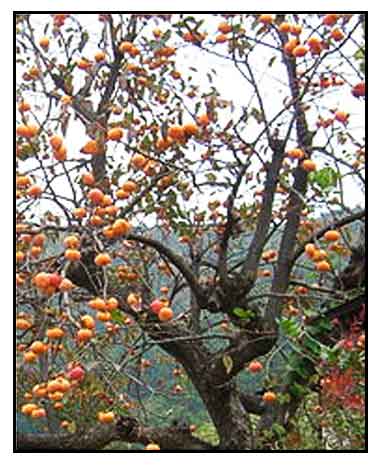 Botany Botany
• Diospyros kaki is a deciduous tree, reaching a height of up to 10 meters. Deciduous leaves are medium to dry green, broadly lanceolate, stiff and equally wide as long. Typically wither male or female, some produce both types of flowers. Flowers are tubular, creamy white, 2 to 2.5 centimeters wide. Female flowers grow singly, while male flowers may have a pink tint and appear in clusters of 3. Sepals are four, crown-shaped; petals are four forming a large calyx. Fruit is yellow or orange to deep red, spherical to oval, bearing the indented stem and four sepals, with a smooth, shiny, thin shell ranging from yellow to red-orange, which may contain up to 8 seeds. (8)
• Small tree, up to 15 m tall. Leaves elliptic or elliptic-ovate, 11-12 X5.3-6 cm, pubescent, acuminate; petiolate. Flowers pedicellate, pedicel 10-15 mm long. Male in 3-flowered cynics; female solitary and larger. Calyx segments oval or broadly lanceolate, pubescent. Corolla yellow-white, lobes rounded. Male flower: stamens 16-24, hairy. Female flower: staminodes 8-10; ovary 8-10-locular, style 4-parted, hairy. Berry globose, 3-7 cm. in diameter, orange to dark red, glossy and fleshy. (Flora of Pakistan)
Distribution
- Introduced.
- Found in the Mountain Province, chiefly in the vicinity of Sagada and Bauko, where it is grown quite extensively. (32)
- Native to Assam, China North-Central, China South-Central, China Southeast, Hainan, Taiwan, Vietnam. (1)
- Grown in many East Asian countries and southern Europe.
Constituents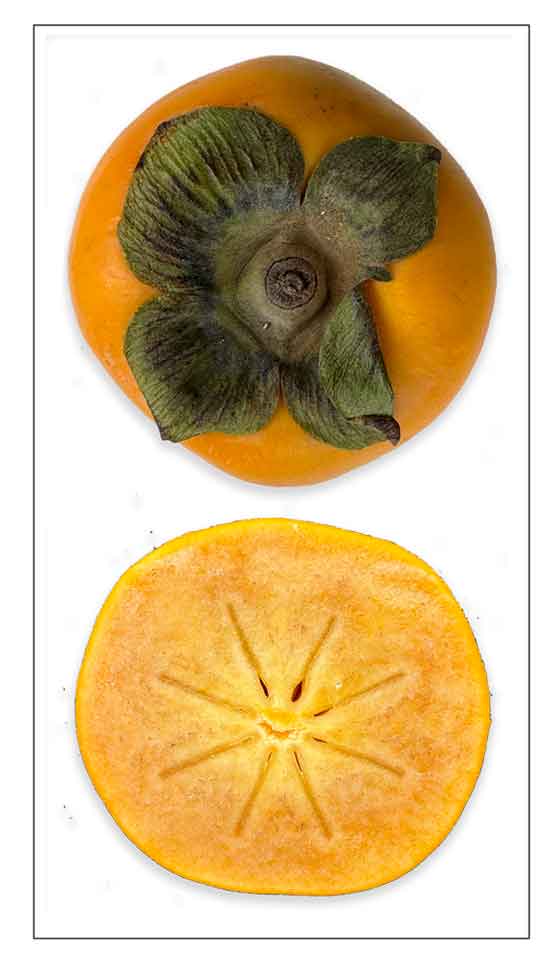
- Nutritional composition of persimmon fruits per 100 grams, raw and dried, yield: (Proximates) water 80.32 and 23.01g, energy 70 and 274 kcal, energy 293 and 1146 kJ, protein 0.58 and 1.38g, total lipid (fat) 0.19 and 0.59g, ash 0.33 and 1.59g, carbohydrate by difference 18.59 and 73.43g, total dietary fiber 3.6 and 14.5g; (Minerals) calcium 8 and 25 mg, iron 0.15 and 0.74 mg, phosphorus 17 and 81 mg, potassium 161 and 802, sodium 1 and 2 mg; (Vitamins) vitamin C 7.5 and 0 mg, riboflavin 0.020 and 00.029mg, niacin 0.100 and 0.180mg, vitamin A 81 and 38 mcgRAE, beta carotene 253 and 374 mc, beta cryptoxanthin 1447 and 156 mc, vitamin A 1627 and 767 IU. (7)
- Chemical structures of phenolic acids (1-9) and catechin (10-16) are: gallic acid (1), protocatechuic acid (2), tannic acid (3), p-hydroxybenzoic acid (4), vanillic acid (5), chlorogenic acid (6), caffeic acid (7), p-coumaric acid (8), ferulic acid (9), epigallocatechin (10), catechin (11), epicatechin (12), epigallocatechin gallate (13), gallocatechin gallate (14), epicatechin gallate (15) and catechin gallate (16) (Lee et al, 2012) (7)
- Major fatty acids found in persimmon seeds are palmitic acid, oleic acid, and linoleic acid, ranging from 70.4% to 78.3% of total fatty acids.
(9)
- Compounds isolated from leaves include flavonols, 40-dihydroxy-a-truxillic acid, tatarine C, myricetin, annulatin, trifolin, astragalin, hyperin, isoquercetin, rutin, quercetin, kampferol, kakispyrone, and kaki saponin.
(9)
- Study on methanol extract of leaves isolated two new ursane-type triterpenoids, 3α-19α-dihydroxyurs-12,20(30)-dien-24,28-dioic acid (1) and 3α-19α-dihydroxyurs-12,-en-24,28-dioic acid (2), along with 12 known ursane- and oleanane-type triterpenoids (3-14). (see study below
(14)
- Study of root bark yielded active compounds A & B, identified as napthoquinones, Plumbagin (5-hydroxyl, 2-methyl 1,4 -Napthoquinone) and Isodiospyrin (5-hydroxy-6-(1-hydroxy-6-methyl-5,8- dioxo-naphthalen-2-yl)-2-methyl-naphthalene-1,4-dione). (see study below) (19)
- Seven amino acids present in fruits were: threonine, isoleucine, phenylalanine, lysine, methionine, valine, and histidine. Flavonoid compounds present in abundance were hesperidin, quercetrin, luteolin, narengin, and rutin in decreasing order.
(37)
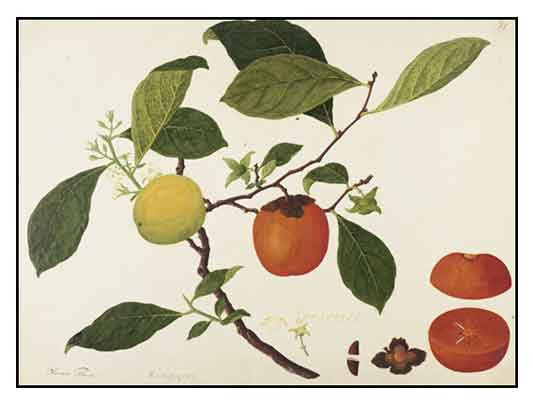 Properties Properties
- Persimmon ripening is climacteric and ripening is regulated by ethylene, during which phase rapid softening occurs resulting in jelly-like flesh, rendering the persimmon unmarketable within a couple of days. (7) The shelf life of persimmon fruits can be increased by slowing the ripening process by inhibiting ethylene biosynthesis or its action, thus enhancing the storage life. (9)
- Fruits are classified into astringent (A) and non-astringent (NA) varieties. In early stages of fruit development, fruits accumulate large amounts of proanthocyanidins (PAs) in specialized tannin cells. Antioxidant activities of astringent fruits are highest compared to non-astringent varieties. With ripening, astringency decreases with about 70-90% decline in total polyphenolic components like tannins. (9)
- The astringent cultivated cultivars fruit contains high proanthocyanidin-type tannin content which makes the immature fruit astringent and bitter. The tannin level decreases as the fruit matures. (8)
- Studies have suggested antioxidant, anti-inflammatory, hepatoprotective, larvicidal, cytotoxic, insecticidal, repellent, antibacterial, antifungal, neuroprotective, analgesic, sedative, cosmeceutical properties.
Parts used
Fruit, leaves.
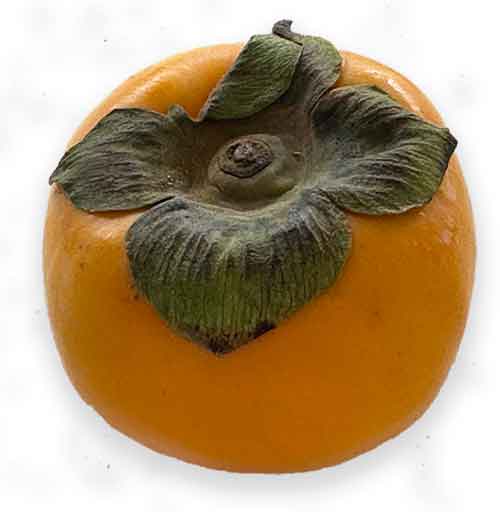 Uses Uses
Edibility
- Whole fruit is edible except the seed and calyx.
-
Fruit is sweet, slightly tangy with a soft to fibrous texture.
- Fruits of astringent cultivars is not edible in its crisp, firm state; becoming edible when ripe and soft.
(8)
- Some cultivars, such as Fuyu, do not contain tannins when firm, and can be eaten like an apple or allowed to go to any stage of ripeness.
(8)
- For drying of the fruit, the peel is removed to prevent the astringency and bitter taste. Dried whole fruit and slices are to to make dried persimmon products. (9)
- Unpeeled whole fruit can be used to make persimmon vinegar and wine. (9)
- In Korea, leaves used as tea for treatment of hypertension. (9)
Folkloric
- In Korean traditional medicine, kaki calyx used to treat bedwetting, vomiting, and hicupping. (4)
- In Chinese traditional medicine, leaves used for treatment of ischemia, stroke, angina, internal hemorrhage, hypertension, atherosclerosis ad various infectious diseases. (5)
- Used for treatment of various skin conditions including acne, skin eruptions, and eczema. (6)
- Decoction of calyx and fruit stem used to treat hiccuping, coughs, and labored breathing. (23)
Others
- Persimmon juice is widely used for waterproofing; reinforcing materials such as wood, paper, cloth, and fishnet; for food preservation, and as colorant or dye. (18)
- Tannin: Tannin from unripe Japanese persimmon has been employed in brewing saki. Also for wood preservation and dyeing. (23)
- Repellent: Juice of small inedible wild persimmon is crushed whole, calyx, seed and all, diluted with water and painted on paper and cloth as insect- and moisture repellent.(23)
- Wood: Wood is hard and heavy, black with streaks of orange-yellow, salmon, brown or gray; prized in Japan for use as fancy inlays. (23)
Studies
• Antioxidant: Study evaluated the antioxidant benefits from persimmon leaf tea, fruit, and fibers in relation to changes along gastrointestinal digestion. Digestion was performed with and without digestive enzymes. Results showed the leaf extracts to be richer in antioxidants than fruit and fibers. Leaf antioxidants were more sensitive to the digestive environment. Oral conditions affected the antioxidants and gastric digestion led to slight additional loses. Digestive enzymes contributed to antioxidant release throughout digestion. Bioaccessiblity of polyphenols, flavonoids, and antioxidant activity of the fruit were 1.4, 1.0 and 3.8 times highest than the aqueous extract of leaf. (3)
• Anti-Inflammatory / Stalks: Study evaluated the potential anti-inflammatory activities of astringent D. kaki stalks based on cultivar types and stages of maturity. using RAW 264.7 cells. All the extracts were nontoxic under 100 µg/ml concentration. Stage 1 samples (8-9 months) all showed high percentage of tannic acid content and Gojongst (Hamyang) showing highest content. Stage 1 samples also showed highest inhibition of NO production. Decreases in expression of iNOS and\ phosphorylated p65 were dose dependent. (4)
• Dermatological and Cosmetic Applications: Study presents the cumulative data o the potential use of D. kaki for its possible role in dermatologic and cosmetic applications. Active principles have been shown to possess anti-inflammatory, antiallergic, photo-protective, and anti-wrinkle effects with activities against tyrosinase, elastase, and collagenase enzymes. Antioxidant and skin whitening potential, along with reduction of sebum content and size and number of skin pores makes it a suitable choice as cosmetic ingredient. Photo protection against degenerative effects of UVA, UVB, and gamma radiation further suggest benefit against oxidative stress and reactive oxygen species. (6)
• Cytotoxic / Leaves: Study yielded two new compounds, kakispyrone (1) and kakisaponin A (2), together with 11 known compounds. The cytotoxic effects against several cancer cell lines (A549, HepG2, and HT29) are reported. (10)
• Interactions: Moderate: Persimmon may further decrease blood pressure in patients taking antihypertensive drugs (captopril, enalapril, losartan, valsartan, diltiazen, amlodipine, HCTZ, furosemide, along others. (11)
• Hepatoprotective / Carbon Tetrachloride Toxicity / Fruits: Study evaluated various fruit part extracts of D. kaki for hepatoprotective activity using CCl4-induced liver damage model, measuring serum enzymes such as SGOT, SGPT, AP and total bilirubin. Results showed dose-dependent hepatoprotective activity, with the ethanol extract showing highly significant activity. (12)
• Protective in Optic Nerve Crush-Induced Retinal Degeneration / Leaves: Retinal ganglion cell (RGC) death is part of many retinal diseases. Study reports on an ethanol extract of leaves exhibiting protective properties against retinal degeneration in both in-vitro and in-vivo tests. Upon exposure to cytotoxic compounds, RGC-5 cell viability was increased in a concentration dependent manner. Cell survival induced by EEDK was associated with decreased levels of apoptotic proteins. Also expression levels of antioxidant associated proteins, such as SOD, glutathione S-transferase and glutathione peroxidase-1 ere positively modulated. In a partial optic-nerve crush model, EEDK showed similar ameliorating effects on retinal degeneration caused by mechanical damage. Results suggest the EEDK may have therapeutic potential against retinal degenerative disorders, such as glaucoma. (13)
• Triterpenoids / Inhibitory Effects on Protein Tyrosine Phosphatase 1B / Leaves: Study on methanol extract of leaves isolated two new ursane-type triterpenoids, 3α-19α-dihydroxyurs-12,20(30)-dien-24,28-dioic acid (1) and 3α-19α-dihydroxyurs-12,-en-24,28-dioic acid (2), along with 12 known ursane- and oleanane-type triterpenoids (3-14). Triterpenoids with 3ß-hydroxygroup inhibited protein tyrosine phosphatase 1B (PTB1B) activity with IC50 ranging from 3.1 ± 0.2 to 18.8 ± 1.3 µM. (14)
• Inhibition of Alkali Burn-Induced Corneal Neovascularization / Leaves: Study evaluated the effect of ethanol extract of D. kaki leaves on corneal neovascularization in rats due to alkali burns. The extract significantly attenuated the upregulation of vascular endothelial growth factor, fibroblast growth factor, interleukin-6, and matrix metalloproteinase 2 (MMP-2) protein levels. (15)
• Phenolic Compound Supplementation Via Phytosomes: Persimmon phenolic compounds (PCs) can mitigate oxidative damage induced by ROS. However, due to large molecular weight and intrinsic instability in some physiologic fluids, passage through biological membranes is very limited. This study evaluated the use of phytosomes containing bioactive phenolic extracts in terms of size, surface change, encapsulation efficiency and stability over six months. The phytosomes were orally doses to Wistar rats over a 15-day period. Compared to free extract, the extract-loaded phytosomes showed higher antioxidant antioxidant activity after six months, and did not cause lipidic profile changes nor changes in glycemia and urine parameters. Results suggest potential of PCs as food supplements and a promising and safe phytosomal formulation. (17)
• Antibacterial / Hydrogen Peroxide / Leaves: Studies revealed persimmon extract generates hydrogen peroxide, with highest levels from leaves. Antibacterial effect of hydrogen peroxide from persimmon leaf was tested using intestinal bacteria. It was found that hydrogen peroxide is generated from persimmon tissues, and the bactericidal activity of persimmon extracts correlated with bacterial sensitivity to hydrogen peroxide. (18)
• Antifungal / Plumbagin and Isodiospyrin / Root Bark: A chloroform extract of root bark of D. kaki exhibited remarkable antifungal activity against all test fungi. Study yielded active compounds A & B identified as plumbagin and isodiospyrin. MIC values of the crude extract and compounds A and B were 160-2500 µg/ml, 1.25-20 µg/ml and 5-160 µg/ml and MFC values of 630-5000 µg/ml, 5-160 µg/ml and 40-160 µg/ml, respectively. (19)
• Topical Cosmetic Skin Cleanser / Reduction of Skin Oil and Pore Size in Humans: Study evaluated the effects of a cosmetic cleanser containing Diospyros kaki folium, Polygonum cuspidatum and Castanea crenata var. dulcis on the removal of sebum and on skin pore size in healthy volunteers aged 20 to 50 years. Compared to control cleanser, skin oil content was significantly decreased with DPC cleanser, along with decrease in pore size and numbers, and also easily removed solidified sebum from the skin. (20)
• Anticancer / Calyx: Study of methanol extracts of persimmon calyx demonstrated cytotoxic effects in human cancer cells. The calyx extract inhibited growth of HT-29 cells in a dose-dependent manner. The extract also exhibited cytotoxicity against HeLa and PANC-1 cells, as well as HT-29 cells. (21)
• Benefits in Benzalkonium Chloride-Induced Murine Dry Eye Model / Leaves: Study evaluated the beneficial effects of oral K. kaki ethanol extract on a mouse dry eye model induced by benzalkonium chloride (BAC). Tear secretion volume (Schirmer's test), tear break-up time (BUT) and fluorescein score were measured on the ocular surface. Results showed prolonged BUT, decreased fluorescein score, increase tear volume and smoother epithelial cells. There was also inhibition of inflammatory response and corneal epithelial cell death in a BAC-induced dry eye murine model. Results suggest a potential treatment for dry eye. (22)
• Bacteriostatic / Anti-Inflammatory / Mycobacterium Avium Complex Disease: It is known that condensed tannins have high antioxidant nativity and bacteriostatic properties. This study evaluated the effects of soluble persimmon-derived tannins on opportunistic MAC disease. Results showed soluble tannin hydrolysate exhibited high bacteriostatic activity against MAC in vitro. In vivo, MAC-infected mice fed a soluble tannin-containing diet showed significantly higher antibacterial activity against MAC and less pulmonary granuloma formation. Pro-inflammatory cytokines were significantly decreased. Results suggest the soluble tannin from persimmon may attenuate the pathogenesis of pulmonary NTM infection. (24)
• Phenolic Compounds / Radical Scavenging Activity: Study evaluated the radical scavenging activity and total and individual phenolics of Mopan persimmon compared with apple, grape, and tomato s controls. Radical scavenging activities against ABTS and DPPH were 23.575 and 22.597 µm trolox (p<0.05). The persimmon showed highest total phenolics content. Of the 6 phenolics, gallic acid was the highest in content and exhibited the strongest antioxidant activity, with much higher antioxidant activity compared to apple, grape and tomato. (25)
• Effect of Plant Extracts and Food Additives on Quality of Dried Persimmon: Study evaluated the effect of direct application of plant extracts on the quality of dried persimmon. Best effect was observed with a combination of clove 18.18%, cinnamon 9.90%, licorice 9.09%, firmament 4.55%, grapefruit seed extract 4.55% and apple cider vinegar 54.54%. The combination improved the moisture content of the fruit and showed antifungal, antibrowning, and antifungal/antibrowning effects following 6-week treatment. There was an increase in overall sugar concentration of dried persimmon. The natural extracts effectively suppressed the quality degradation during drying of persimmon and may be used to replace sulfur fumigation (26)
• Brassinosteroids / Role in Fruit Ripening: Brassinosteroids (BRs) are phytohormones that regulate numerous processes including fruit ripening. Study evaluated D. kaki fruits treated with 24-epibrassinolide (EBR) or brassinazole (BrZ, a BR biosynthesis inhibitor). Results showed endogenous BR contents gradually increased during persimmon fruit ripening. EBR treatment resulted in increased of water-soluble pectin and significantly reduced content of acid-soluble pectin and cellulose, resulting in rapid fruit softening. Results suggest BRs influence persimmon fruit ripening by influencing cell-wall-degrading enzymes and ethylene biosynthesis. (27)
• Larvicidal / Insecticidal / Antioxidant / Brine Shrimp Toxicity / Leaves: Aqueous extract of leaves showed moderate to outstanding larvicidal activity (100% to 28%) at 100% to 10% concentrations after 24 hours, with 42% LC50, compared to permitrin with 100% lethality at 0.3%. The extract showed outstanding cytotoxicity against brine shrimp nauplii (Artemia salina) with 10PPM LC50. Also, insecticidal potential was 100% against Culex lectularius. The extract demonstrated 30.22% DPPH radical scavenging activity, compared to quercetin, gallic acid, and acetic aid at 98, 96, and 97% activity, respectively. (28)
• Acute Oral Toxicity and Genotoxicity Studies / Polysaccharide Fraction / Leaves: Study evaluated the acute toxicity and genotoxicity of polysaccharide fraction of leaves. In acute toxicity testing in Sprague-Dawley rats, no mortality, body weight, behavioral changes and adverse effects were observed in male and female rats up to 5,000 mg/kbw dose. In genotoxicity evaluation, the polysaccharide fraction did not significantly increase the number of bacterial colonies in bacterial reverse mutation test, with no observed DNA damage and chromosomal aberration in CHO-k1 cells. (29)
• Protective Effect Against Glucose-Oxygen-Serum Deprivation-Induced PC12 Cells Injury: Ischemic cardiovascular disease is a common cause of death in the world. In-vitro study evaluated the effects of hydroalcoholic extract of peel and fruit pulp of persimmon on cell viability and markers of oxidative damage, mainly intracellular reactive oxygen species (ROS) induced by glucose-oxygen serum deprivation (GOSD) in PC12 cells. GSOD produced significant cell death accompanied by increased level of ROS. Pretreatment with peel and pulp extract markedly restored the changes only at high concentrations. Results suggest protection of PC12 cells from GOSD-induced injury via antioxidant mechanisms, and suggests potential therapeutic application for management of cerebral ischemia and other neurodegenerative disorders. (30)
• Anti-Inflammatory / Analgesic / Sedative / Air-Dried Roots: Study evaluated chloroform extract (CE) and isolated compounds for anti-inflammatoy, analgesic, and sedative activities in animal models. The extract attenuated carrageenan-induced and histamine-induced paw edema (93.98 and 89.54%, respectively). Compound 1 attenuated biphasic edema associated with histamine and prostaglandins. By hotplate analgesiometer, CE showed moderate analgesic effect, while compound 1 showed significant analgesic potential (p<0.001) by increasing latency time in thermally induced algesia model. Compound 1 exhibited significant sedative effect on locomotor activity and dose-dependent analgesic activity. Results supports folkloric usage of D. kaki in treatment of inflammation, pain, and insomnia. (33)
• Antioxidant / Lipoxygenase Inhibitory / Muscle Relaxant: Study evaluated the isolated bioactive metabolites from chloroform fractions o D. kaki. Compound 1, n-hexane, and chloroform fractions were evaluated for invitro antioxidant, lipoxygenase inhibitory, and muscle relaxant potency. The chloroform extract (CE) showed 79.54% interaction with DPPH at higher concentration (100 µg/ml), while compound 1 showed maximum effect of 95.09% at 100 µg/ml. Compound 1 exhibited significant lipoxy-genase inhibitory activity with IC50 of 36/98 µM. Compound 1 and CE showed excellent muscle relaxant activity. Results rationalizes traditional use of D. kaki for treatment of various diseases. (34)
• Diospyrobezoars and Persimmons: Bezoars are thick hard masses found in the gastrointestinal tract, usually the stomach, more likely to develop in patients who have undergone stomach surgery with delayed gastric emptying time. Phytobezoars are the most common type of bezoars, composed of skin, seeds, vegetative material including lignin, cellulose, hemicelluloses, tannins, and other nondigestible matter from fruits and vegetables. Diospyrobezoars are phytobezoars related to persimmon fruit consumption. They are hard and difficult to treat. Consumption of unripe persimmons, with it high level of tannin, may form a coagulum in the stomach due to contact of tannin and shibuol with hydrochloric acid that accumulates cellulose, hemicellulose, and protein. Treatment may require endoscopy or surgical removal. A nonsurgical approach suggested for small intestinal obstruction consists of partial bezoar dissolution though oral and injected Coca-Cola therapy. (35) Giant diospyrobezoars in the duodenum has been successfully treated with Coca-Cola therapy-- believed to dissolve the hard surface of the bezoar -- and endoscopic electrosurgical endo-knife and ileus tube. The method is a treatment option before surgical management of large diospyrobezoars. (36)
Availability
- Wildcrafted.
-
Cultivated
- Fruits in the Manila markets. |

![]()







 Uses
Uses